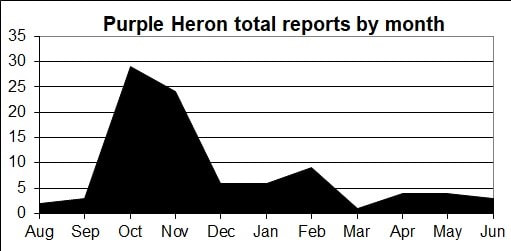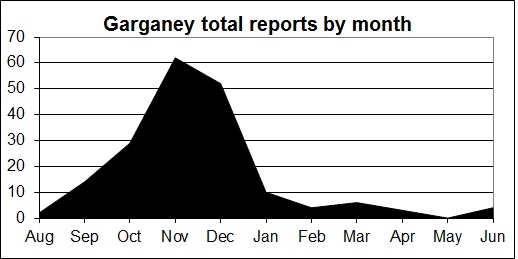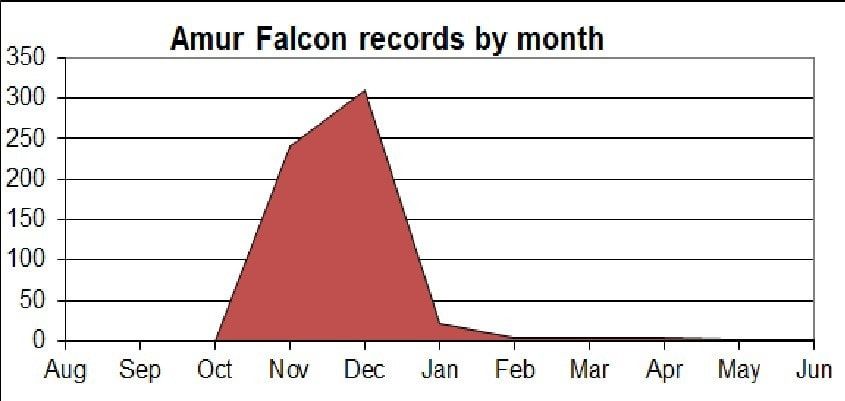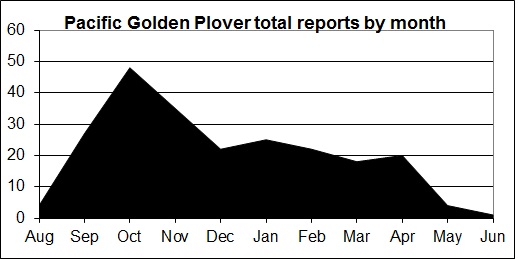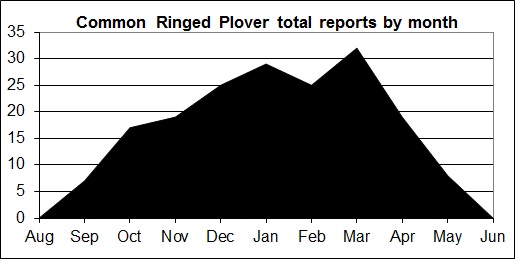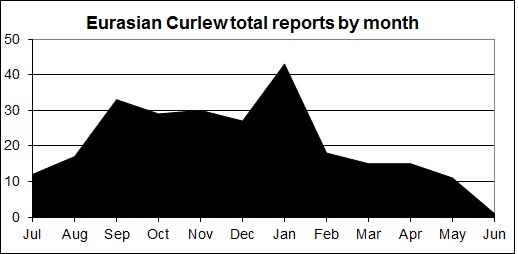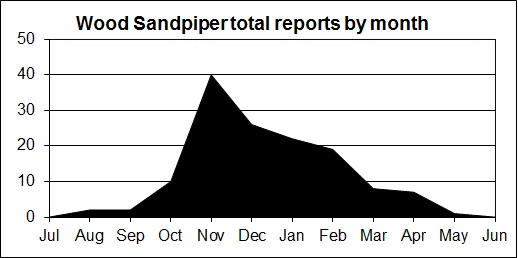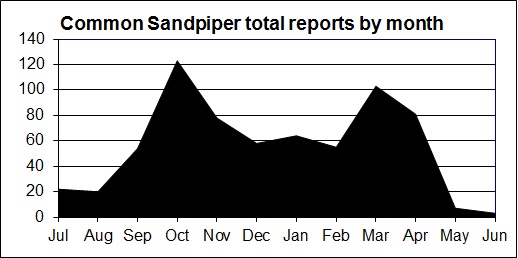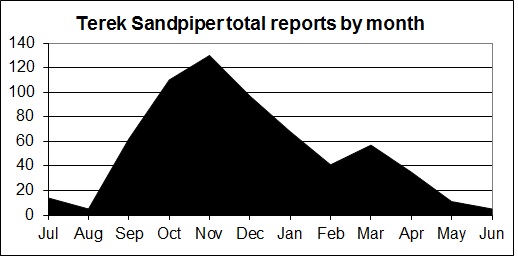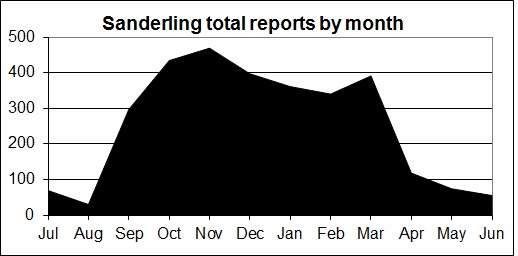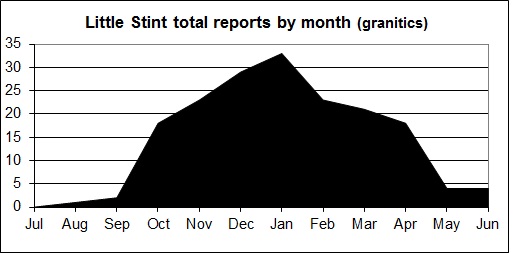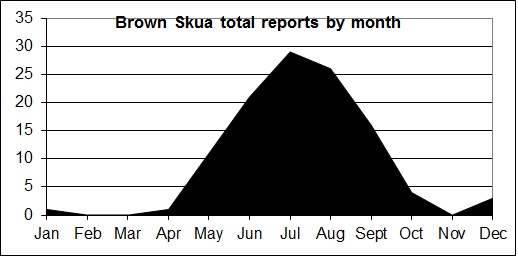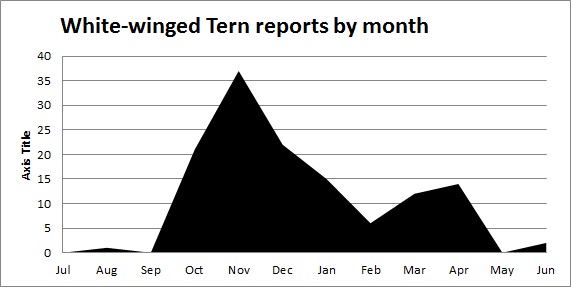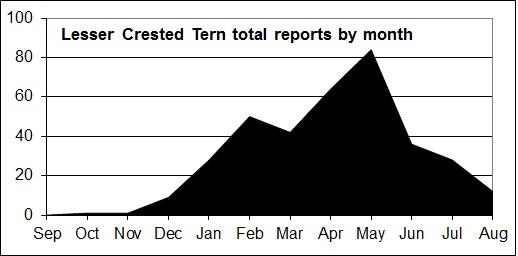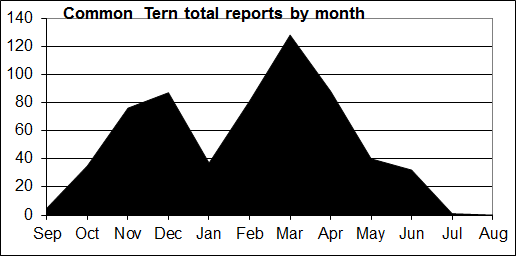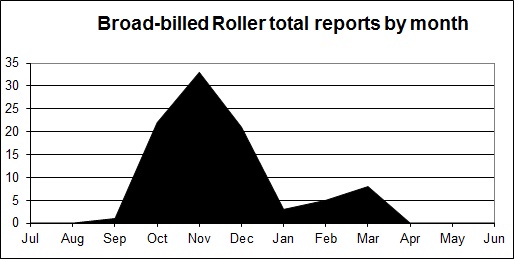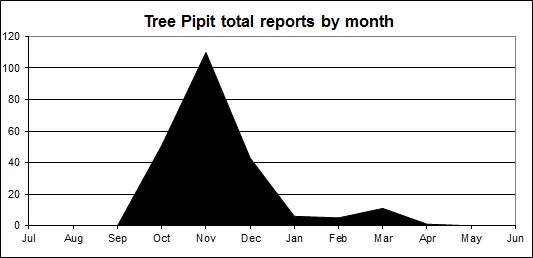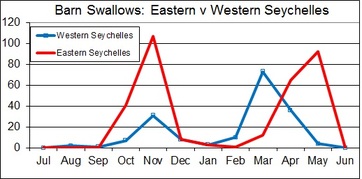ANNUAL MIGRANTS
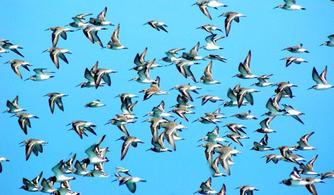
Waders are common annual migrants
to Seychelles
SBRC classifies 30 bird species as annual migrants to Seychelles, including 17 species of waders. The others comprise five seabirds, one heron, one duck, one raptor and five other land birds. We collect reports of annual migrants and in generally automatically accept these without supporting details. Occasionally more details may be requested if reports include an unusual unusual number of birds or time of year.
Although record forms are not requested, SBRC collects regular wader counts and all reports of less common annual migrants: Purple Heron, Garganey, Amur Falcon, Brown Skua, White-winged Tern, Broad-billed Roller, Eurasian Golden Oriole, Blue-cheeked Bee-eater, Tree Pipit and Barn Swallow.
New criteria for considering a species as an annual visitor to Seychelles were agreed at the 20th annual meeting of SBRC in December 2011. A species will be eligible to be considered as annual if it has been recorded in at least 8 of the previous 10 years with an average of at least 2 records per annum. However, this will not apply where a species is very easily confused with one of more other species (e.g.Common Cuckoo and Lesser Cuckoo).
The full list of annual migrants is as follows, with all considered as annual throughout Seychelles unless otherwise stated:
Purple Heron Ardea purpurea (annual east of 52˚E only; vagrant to Aldabra and Farquhar groups)
Garganey Anas querquedeula (annual east of 52˚E only; vagrant to Aldabra and Farquhar groups)
Amur Falcon Falco amurensis (annual east of 52˚E only; vagrant to Aldabra and Farquhar groups)
Crab Plover Dromas ardeola
Pacific Golden Plover Pluvialis fulva (annual east of 52˚E only; vagrant to Aldabra and Farquhar groups)
Grey Plover Pluvialis squatarola
Common Ringed Plover Charadrius hiaticula
Lesser Sandplover Charadrius mongolus
Greater Sandplover Charadrius leschenaultii
Bar-tailed Godwit Limosa lapponica
Whimbrel Numenius phaeopus
Eurasian Curlew Numenius arquata
Common Greenshank Tringa nebularia
Wood Sandpiper Tringa glareola (annual east of 52E only; vagrant to Aldabra and Farquhar groups)
Common Sandpiper Actitis hypoleucos
Terek Sandpiper Xenus cinereus (annual east of 52˚E only; vagrant to Aldabra and Farquhar groups)
Ruddy Turnstone Arenaria interpres
Curlew Sandpiper Calidris ferruginea
Sanderling Calidris alba
Little Stint Calidris minuta
Brown Skua Catharacta antarctica
White-winged Tern Chlidonias leucopterus (annual in granitics, vagrant west of Mahe)
Lesser Crested Tern Thalasseus bengalensis
Common Tern Sterna hirundo
Saunders's Tern Sternula saundersi
Broad-billed Roller Eurystomus glaucurus (annual in Aldabra Group only; vagrant east of Aldabra)
Blue-cheeked Bee-eater Merops persicus
Tree Pipit Anthus trivialis
Barn Swallow Hirundo rustica
Eurasian Golden Oriole Oriolus oriolus
Purple Heron Ardea purpurea (annual east of 52˚E only; vagrant to Aldabra and Farquhar groups)
Garganey Anas querquedeula (annual east of 52˚E only; vagrant to Aldabra and Farquhar groups)
Amur Falcon Falco amurensis (annual east of 52˚E only; vagrant to Aldabra and Farquhar groups)
Crab Plover Dromas ardeola
Pacific Golden Plover Pluvialis fulva (annual east of 52˚E only; vagrant to Aldabra and Farquhar groups)
Grey Plover Pluvialis squatarola
Common Ringed Plover Charadrius hiaticula
Lesser Sandplover Charadrius mongolus
Greater Sandplover Charadrius leschenaultii
Bar-tailed Godwit Limosa lapponica
Whimbrel Numenius phaeopus
Eurasian Curlew Numenius arquata
Common Greenshank Tringa nebularia
Wood Sandpiper Tringa glareola (annual east of 52E only; vagrant to Aldabra and Farquhar groups)
Common Sandpiper Actitis hypoleucos
Terek Sandpiper Xenus cinereus (annual east of 52˚E only; vagrant to Aldabra and Farquhar groups)
Ruddy Turnstone Arenaria interpres
Curlew Sandpiper Calidris ferruginea
Sanderling Calidris alba
Little Stint Calidris minuta
Brown Skua Catharacta antarctica
White-winged Tern Chlidonias leucopterus (annual in granitics, vagrant west of Mahe)
Lesser Crested Tern Thalasseus bengalensis
Common Tern Sterna hirundo
Saunders's Tern Sternula saundersi
Broad-billed Roller Eurystomus glaucurus (annual in Aldabra Group only; vagrant east of Aldabra)
Blue-cheeked Bee-eater Merops persicus
Tree Pipit Anthus trivialis
Barn Swallow Hirundo rustica
Eurasian Golden Oriole Oriolus oriolus
Migration patterns of annual species
Because they occur more frequently than vagrants, the collection of records of annual migrants makes it easier to identify migration patterns. The following graphs and details cover records collected by SBRC
|
Purple Heron is annual in eastern Seychelles and a vagrant in western Seychelles. It has been recorded in every month with a marked peak in October-November (57% of sightings).
|
Garganey is annual in eastern Seychelles and vagrant in western Seychelles. Numbers peak in November, with 92% recorded in the period October-February followed by a steep decline.
|
|
Amur Falcons are annual visitor to eastern Seychelles, mainly in mid-November to mid-December, are in November-December. Although more arrive in November than any other month, the earliest arrival date is not until 15 November. All records are from eastern Seychelles. There is no evidence of northbound migration in Seychelles.
|
Crab PloverRecorded in all months throughout Seychelles, but mainly December-May. Counts in excess of 1,000 are regular at Aldabra and St Francois. Much smaller numbers are recorded in the granitics (with maximum 37 at Providence, Mahe in March 2007 and December 2008; AP Skerrett).
The record counts for the southern atolls are: Aldabra 3,813 in March 2007 (P Pistorius & A Hermans) St Francois 1,750 in March 2007 (M Betts) |
|
Pacific Golden Plover is annual in eastern Seychelles and a vagrant in western Seychelles recorded in all months, but mainly September-April, numbers peaking in October and steadily declining thereafter.
|
Grey PloverRecorded in all months throughout Seychelles, most frequent October-May. By far and away The largest numbers are recorded at St Francois, with a record count of 508 in March 2009 (PA Adam). Much smaller numbers occur in the granitics where the record count is 100 at Mahe in January 1982 (NJ Phillips). Counts of up to 50 birds have been recorded at Aldabra.
|
Sandplovers
Lesser and Greater Sandplover are recorded throughout Seychelles September-May frequently recorded together in counts and regularly numbering low hundreds at Aldabra. However, Greater Sandplover is by far the most common.
|
Common Ringed Plover
|
Bar-tailed GodwitRecorded in all months throughout Seychelles, most frequent October-March. The largest numbers are recorded at St Francois and Aldabra with the highest counts of 150 at St Francois in October 2008 (PA Adam) and 221 at Aldabra in January 1999 (M Betts). Elsewhere the highest count is 15 at Mahe in November-December 1994 (A Henderson).
|
WhimbrelRecorded in all months throughout Seychelles, most frequent October-March. The largest numbers are recorded at St Francois with the highest count 600 in March 2007 (M Betts). At Aldabra the highest recorded count is 179 in March 2000 (M Betts). In the islands of the Seychelles Bank the highest count is 100 at Bird in November 2010 (NJ Phillips).
|
Eurasian Curlew is annual throughout Seychelles recorded in all months ( but only once in June). The record count is 15 at Mahe in January 1982 (NJ Phillips).
|
Common GreenshankRecorded in all months throughout Seychelles, most frequent November-April. The highest count is at Mahe in January 1989 (ID Bullock). At Aldabra 50 have been recorded twice, in March 2000 (M Betts) and March 2006 (T Mahoune).
|
Wood Sandpiper is annual on northern autumn passage in eastern Seychelles with 85% of records October-January and no evidence of any spring paasage. There are just a handful of sightings May-September. It is a vagrant in western Seychelles (8 records). The record count is 8 at Mahe in February 2007 (M Betts & AP Skerrett).
|
|
Common Sandpiper is annual throughout Seychelles mainly September-April, very rarely seen outside this period. There are marked peaks in sightings on autumn migration in October and spring migration in March. The maximum recorded is 23 at Aldabra March 1999 (M Betts). At Mahe the maximum recorded is 10 at Victoria in March 1973 (CJ Feare and J High).
|
Terek Sandpiper is annual in the granitics September-April with a peak in October, steadily declining thereafter, but recorded in all months and with some suggestion of a spring migration through the islands in March. Maximum 26 at Mahe in September 1991 (R Gerlach). It is a vagrant to Amirantes (10 records, mainly Alphonse and St Francois) and Aldabra (16 records, maximum 12 in December 1967 (M Penny).
|
|
Little Stint us an annual visitor to the granitics
September-May, with a peak in January. It is a vagrant to the outer islands recorded only at Aldabra (5 times), Desroches (twice) and St Francois (once). The maximum recorded in the granitics is 16 in April 1973 (CJ Feare and J High). |
Curlew SandpiperCurlew Sandpiper is a common annual migrant throughout Seychelles recorded all months, but mainly October-March. Maximum recorded 700 at Aldabra in January 1999 (M Betts). The maximum recorded in the granitics is 600 at Mahe in February 1974 (CJ Feare and J High). There is some evidence of a sharp decline in numbers wintering in Seychelles.
|
|
Brown Skua is annual in small numbers throughout Seychelles recorded mainly off Aride. In the granitics, except for a single December record, the earliest sighting is 30 April and latest sighting 9 October. In the southern atolls there have been far fewer reports but half of them in the November-January.
|
White-winged Tern is an annual visitor to islands of the Seychelles Bank with only 9 reports from Aldabra and one from Amirantes (Desnoeufs). Numbers peak on northern autumn migration in October with a much smaller spring migration peak in March.
|
|
Lesser Crested Tern is annual in small numbers
throughout Seychelles November-June with a peak in January. It is highly migratory, with no records July-late October. Maximum count is 25 at Mahe in April 2011 (AP Skerrett) In the outer islands the maximum count is 8 at St Francois in February 2009 (PA Adam) and 7 at Aldabra in December 1998 (M Betts) and March 2004 (T Mahoune). |
Common Tern is annual throughout Seychelles mainly October-June, with peaks for autumn passage in December and spring passage in March-May. Maximum recorded is 72 off North Island in March 2006 (B Simpson & U Bristol).
|
|
Saunders's Tern
Saunders's Tern is annual throughout Seychelles mainly September-April but recorded every month except June. The maximum recorded is 1,800 at St Francois in January 2008 (PA Adam). At Aldabra the maximum count is 800 at in October 1997 (R Chapman). The Maximum recorded at islands of Seychelles Bank is 380 at Bird in December 2004 (TR Bresson). |
Broad-billed Rolleris annual in the Aldabra Group and a vagrant further east. More than 80% of reports are October to December.
|
|
Tree Pipit is annual throughout the islands October to mid-March, with 90% records October-December and a peak in November. It was originally considered a vagrant by SBRC until reclassified as annual at the 2004 Annual Meeting. Earliest autumn migration record 1 October 2000 on Aride (J Bowler), latest spring migration record 13 March 2004 at Aldabra (U Samedi). There apprears to be a slight spring migration peak in March but more data is needed to confirm.
|
Barn Swallow is annual throughout the islands. It is the only land bird that appears to pass through Seychelles regularly in numbers on both northern and southern migration. The autumn migration peak coincides at all locations in November but the spring migration peak at Aldabra is in March whereas at other islands it is significantly later in April-May. It was considered a vagrant by SBRC until reassessed as annual at the 2004 Annual Meeting.
|
